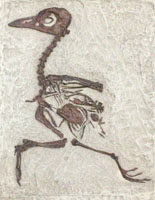This skeleton (Gallinuloides wyomingensis) is a replica of a primitive pheasant (galliform) of the Gallinae suborder.
In the class Aves there are two subclasses: Archaeornithes (ancient birds) and Neornithes (modern birds). Gallinuloides belongs to the later class, Neornithes. Within the Neornithes subclass are three suborders: Odontognathae, Palaeognathae, and Neognathae. Gallinuloides belongs to the Neognathae order and the family Cracidae. Gallinuloides wyomingensis was found in the fine grained limestone layers of the Eocene Epoch, of the Green River Formation, in Kemmerer, Wyoming.
The Green River Formation was formed by a system of three fresh water lakes which covered parts of Colorado, Utah, and Wyoming. The area covered by these lakes (Fossil, Gosiute, and Uinta) was about 25,000 square miles. The life span for these three lakes was: over 17 million years for Lake Uinta, about 6 million for Lake Gosiute, and only about 2 million for Fossil Lake. The average deposition thickness of these three lakes is about 2,000 feet. The deposition depth at the center of Fossil Lake is about 200-260 feet thick. Lake Uinta deposition is in excess of 7,000 feet in places. Based on the types of flora and fauna found in the Green River Formation, it indicates that temperate to sub-tropical conditions existed, similar to the Gulf Coast of the United States.
Gallinuloides wyomingensis probably fell or died and was washed into the lake and was covered by the fine grained limestone sands. The specimen has been nicknamed "The Running Bird" by those who found it. We affectionately call it "Chicken Little." Chicken Little ran around saying "the sky is falling, the sky is falling" and in this case that's exactly what happened. Volcanic ash fell, suffocating the pheasant chick, and subsequently covered it up. The sky really was falling.
The original for this specimen is currently in the possession of the Smithsonian Institution in Washington, DC.
Gallinuloides wyomingensis 
Quantity in Basket: None
Code: AVE-300
Price: $178.50
Shipping Weight: 1.64 pounds
Time: Eocene Epoche, approximately 55 million years ago
Location: Green River Formation, Wyoming, USA
Dimensions: 11-3/4" x 9-1/2" x 1-1/2"